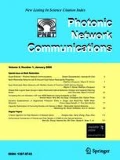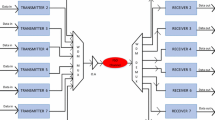Abstract
Free space optical (FSO) communication link based on orthogonal frequency division multiplexing (OFDM) gives improved performance because of high bandwidth efficiency, improved robustness against fading, and narrow-band interference. Any FSO system requires line-of-sight (LoS) link and in non-LoS (NLoS) situation, the two users cannot communicate directly resulting in link outage. To solve this problem, this paper proposes to use relay-assisted NLoS-FSO link with energy-saving three time-slotted analog network-coding approach to make the successful communication with increased throughput and improved error performance. The error performance of laser link is evaluated in terms of receiver sensitivity. Gamma–Gamma distribution is used for atmospheric turbulence in this analysis. The performance of relay-assisted intensity modulated/direct detected-OFDM FSO link with and without analog network coding (ANC) is compared.















Similar content being viewed by others
References
Kazaura, K., Wakamori, K., Matsumoto, M., Higashino, T., Tsukamoto, K., Komaki, S.: RoFSO: a universal platform for convergence of fiber and free-space optical communication networks. IEEE Comm. Mag. 48(2), 130–137 (2010). doi:10.1109/MCOM.2010.5402676
Tsukamoto, K., Hashimoto, A., Aburakawa, Y., Matsumoto, M.: The case for free space. IEEE Microw. Mag. 10(5), 84–92 (2009). doi:10.1109/MMM.2009.933086
Bekkali, A., Dat, P.T., Kazaura, K., Wakamori, K., Matsumoto, M., Higashino, T., Tsukamoto, K., Komaki, S.: Performance evaluation of an advanced DWDM RoFSO system for transmitting multiple RF signals. IEICE Trans. Fundam. Electron. Commun. Comput.Sci. 92(11), 2697–2705 (2009)
Akbulut, A., Efe, M., Ceylan, A.M., Ari, F., Telatar, Z., Ilk, H.G., Tugac, S.: An experimental hybrid FSO/RF communication system. In: Proceedings of the IASTED International Conference on Communication System and Networks, CSN 2003, Benalmdena, Spain pp. 406–411 (2003)
Vaiopoulos, N., Sandalidis, H.G., Varoutas, D.: WiMAX on FSO: outage probability analysis. IEEE Trans. Commun. 60(10), 2789–2795 (2012). doi:10.1109/TCOMM.2012.071212.110182
Cvijetic, N., Wilson, S.G.: OPN01-4: WiMAX access using optical wireless technology with heterodyne detection in turbulent atmospheric channels. IEEE Globecom 2006, 1–5 (2006). doi:10.1109/GLOCOM.2006.361
Cvijetic, N., Wang, T.: WiMAX over free-space optics—evaluating OFDM multi-subcarrier modulation in optical wireless channels. In: Sarnoff Symposium, 2006 IEEE, pp. 1–4 (2006). doi:10.1109/SARNOF.2006.4534760
Cvijetic, N., Wang, T.: A MIMO Architecture for IEEE 802.16d (WiMAX) Heterogeneous wireless access using optical wireless technology. In: Koucheryavy, Y., Harju, J., Iversen, V.B. (eds.) Next Generation Teletraffic and Wired/Wireless Advanced Networking: Proceedings of 6th International Conference, NEW2AN 2006, St. Petersburg, Russia, May 29–June 2, 2006, pp. 441–451. Springer, Berlin (2006). doi:10.1007/11759355_40
Cvijetic, N., Qian, D., Wang, T.: 10Gb/s free-space optical transmission using OFDM. In: Optical Fiber communication/National Fiber Optic Engineers Conference, 2008. OFC/NFOEC 2008, pp. 1–3. doi:10.1109/OFC.2008.4528442
Zdravkovi, N., Petkovic, M.I., Djordjevic, G.T., Kansanen, K.: Outage analysis of mixed FSO/WiMAX link. IEEE Photonics J. 8(1), 1–14 (2016). doi:10.1109/JPHOT.2016.2516250
Bekkali, A., Naila, C.B., Kazaura, K., Wakamori, K., Matsumoto, M.: Transmission analysis of OFDM-based wireless services over turbulent radio-on-FSO links modeled by Gamma–Gamma distribution. IEEE Photonics J. 2(3), 510–520 (2010). doi:10.1109/JPHOT.2010.2050306
Sharma, M., Chadha, D., Chandra, V.: Performance analysis of spatially multiplexed MIMO-OFDM free space optical communication system. In: 2014 International Conference on Signal Processing and Communications (SPCOM), pp. 1–5 (2014). doi:10.1109/SPCOM.2014.6983942
Sharma, M., Chadha, D., Chandra, V.: Capacity evaluation of MIMO-OFDM free space optical communication system. In 2013 Annual IEEE India Conference (INDICON), pp. 1–4 (2013). doi:10.1109/INDCON.2013.6726078
Bai, F., Su, Y., Sato, T.: Performance evaluation of a dual diversity reception base on OFDM RoFSO systems over correlated log-normal fading channel. In: Proceedings of the 2014 ITU Kaleidoscope Academic Conference: Living in a converged world - Impossible without standards?, pp. 263–268 (2014). doi:10.1109/Kaleidoscope.2014.6858473
Wang, Y., Wang, D., Ma, J.: On the performance of coherent OFDM systems in free-space optical communications. IEEE Photonics J. 7(4), 1–10 (2015). doi:10.1109/JPHOT.2015.2450532
Kumar, P., Srivastava, A.: Enhanced performance of FSO link using OFDM and comparison with traditional TDM-FSO link. In: IEEE International Broadband and Photonics (IBP) Conference, Bali, Indonesia, pp. 1–6 (2015). doi:10.1109/ANTS.2013.6802858
Kumar, P., Srivastava, A.: Performance improvement of OFDM-FSO multi-user communication system with combined transmit frequency diversity and receive space diversity. Optics Communications 366, 410–418 (2016). doi:10.1016/j.optcom.2015.12.059. http://www.sciencedirect.com/science/article/pii/S0030401815303928
Nee, R.V., Prasad, R.: OFDM for Wireless Multimedia Communications, 1st edn. Artech House Inc, Norwood (2000)
Shieh, W., Djordjevic, I.: Orthogonal frequency division multiplexing for optical communications. Academic Press, Cambridge (2010)
Gonzalez, O., Perez-Jimenez, R., Rodriguez, S., Rabadan, J., Ayala, A.: Adaptive OFDM system for communications over the indoor wireless optical channel. IEE Proc. Optoelectron. 153(4), 139–144 (2006). doi:10.1049/ip-opt:20050081
Armstrong, J., Schmidt, B.J.C., Kalra, D., Suraweera, H.A., Lowery, A.J.: SPC07-4: performance of asymmetrically clipped optical OFDM in AWGN for an intensity modulated direct detection system. IEEE Globecom 2006, 1–5 (2006). doi:10.1109/GLOCOM.2006.571
Wilson, S.K., Armstrong, J.: Digital modulation techniques for optical asymmetrically-clipped OFDM. In: 2008 IEEE Wireless Communications and Networking Conference, pp. 538–542 (2008). doi:10.1109/WCNC.2008.100
Dissanayake, S.D., Armstrong, J.: Comparison of ACO-OFDM, DCO-OFDM and ADO-OFDM in IM/DD systems. J. Lightwave Technol. 31(7), 1063–1072 (2013). doi:10.1109/JLT.2013.2241731
Ranjha, B., Kavehrad, M.: Hybrid asymmetrically clipped OFDM-based IM/DD optical wireless system. IEEE/OSA J. Opt. Commun. Netw. 6(4), 387–396 (2014). doi:10.1364/JOCN.6.000387
Wu, N., Bar-Ness, Y.: A novel power-efficient scheme asymmetrically and symmetrically clipping optical (ASCO)-OFDM for IM/DD optical systems. EURASIP J. Adv. Signal Process. 2015(1), 3 (2015). doi:10.1186/1687-6180-2015-3
Gui, T., Li, C., Yang, Q., Xiao, X., Meng, L., Li, C., Yi, X., Jin, C., Li, Z.: Auto bias control technique for optical OFDM transmitter with bias dithering. Opt. Express 21(5), 5833–5841 (2013). doi:10.1364/OE.21.005833
Zhang, M., Zhang, Z.: An optimum DC-biasing for DCO-OFDM system. IEEE Commun. Lett. 18(8), 1351–1354 (2014). doi:10.1109/LCOMM.2014.2331068
Armstrong, J., Schmidt, B.J.C.: Comparison of asymmetrically clipped optical OFDM and DC-biased optical OFDM in AWGN. IEEE Commun. Lett. 12(5), 343–345 (2008). doi:10.1109/LCOMM.2008.080193
Patel, D., Singh, V.K., Dalal, U.D.: Assessment of the DC bias to mitigate the clipping noise in DCO-OFDM, ACO-OFDM; and non-linear distortion of DFB laser transmitted through dispersive single mode fibers in IM/DD Systems. Wirel. Pers. Commun., 1–20 (2017). doi:10.1007/s11277-017-4170-y
Chen, L., Krongold, B., Evans, J.: Theoretical characterization of nonlinear clipping effects in IM/DD optical OFDM systems. IEEE Trans. Commun. 60(8), 2304–2312 (2012). doi:10.1109/TCOMM.2012.060112.110136
Bohren, C., Huffman, D.: Absorption and Scattering of Light by Small Particles. Wiley, New York (2008). https://books.google.co.in/books?id=ib3EMXXIRXUC
El-Shimy, M.A.E.H.: Communications Through Non-Line-of-Sight Solar-Blind Ultraviolet Scattering Channels. McMaster University, Hamilton (2014). http://hdl.handle.net/11375/16231
Kolka, Z., Biolek, D., Biolkova, V.: Simulation of atmospheric optical channel with ISI. In: Proceedings of the 8th WSEAS International Conference on Circuits, Systems, Electronics, Control & Signal Processing, CSECS’09, pp. 198–201. World Scientific and Engineering Academy and Society (WSEAS), Stevens Point (2009). http://dl.acm.org/citation.cfm?id=1736282.1736317
Kumar, P., Srivastava, A.: Receiver sensitivity improvement of OFDM-FSO link using SRM device. In: 2015 IEEE International Conference on Advanced Networks and Telecommuncations Systems (ANTS), pp. 1–6(2015). doi:10.1109/ANTS.2015.7413645
Kumar, N., Teixeira, A.L.J.: 10 Gbit/s OFDM based FSO communication system using M-QAM modulation with enhanced detection. Opt. Quantum Electron. 48(1), 1–7 (2015). doi:10.1007/s11082-015-0272-5
Sharma, V., Kumar, N.: Improved analysis of 2.5 Gbps-inter-satellite link (ISL) in inter-satellite optical-wireless communication (IsOWC) system. Opt. Commun. 286, 99–102 (2013). doi:10.1016/j.optcom.2012.08.055. http://www.sciencedirect.com/science/article/pii/S0030401812009030
Liew, S.C., Zhang, S., Lu, L.: Physical-layer network coding: Tutorial, survey, and beyond. Phys. Commun. 6, 4–42 (2013). doi:10.1016/j.phycom.2012.05.002. http://www.sciencedirect.com/science/article/pii/S1874490712000419. Network Coding and its Applications to Wireless Communications
Abu-Almaalie, Z., Ghassemlooy, Z., Le-Minh, H., Aslam, N.: Physical layer network coding with two-way relay free space optical communication link. In: 2015 Internet Technologies and Applications (ITA), pp. 292–297 (2015). doi:10.1109/ITechA.2015.7317412
He, F., Chen, X., Xiao, L., Zhou, S.: Low complexity power allocation for two-way decode-and-forward OFDM relay networks. In: 2016 IEEE/CIC International Conference on Communications in China (ICCC), pp. 1–6 (2016). doi:10.1109/ICCChina.2016.7636718
Huang, G., Tang, D.: Wireless information and power transfer in two-way OFDM amplify-and-forward relay networks. IEEE Commun. Lett. 20(8), 1563–1566 (2016). doi:10.1109/LCOMM.2016.2570751
Trinh, P.V., Thang, T.C., Pham, A.T.: Two-way all-optical AF relaying FSO systems over Malaga (M) channels with pointing errors. In 2016 IEEE International Conference on Communications (ICC), pp. 1–7 (2016). doi:10.1109/ICC.2016.7511176
Ezzine, S., Abdelkefi, F., Cances, J.P., Meghdadi, V., Bouallgue, A.: Channel capacity and SA-BER performances evaluation of an OFDM-based two-way relaying AF-PNC-PLC systems. In: 2016 IEEE 30th International Conference on Advanced Information Networking and Applications (AINA), pp. 39–46 (2016). doi:10.1109/AINA.2016.150
Katti, S., Gollakota, S., Katabi, D.: Embracing wireless interference: analog network coding. In: Proceedings of the 2007 Conference on Applications, Technologies, Architectures, and Protocols for Computer Communications, SIGCOMM ’07, pp. 397–408. ACM, New York (2007). doi:10.1145/1282380.1282425
Gacanin, H., Adachi, F.: Broadband analog network coding. IEEE Trans. Wirel. Commun. 9(5), 1577–1583 (2010). doi:10.1109/TWC.2010.05.091053
Sjodin, T.: A channel estimation scheme for analog network coding based on OFDM in multipath fading environment (2009). http://www8.cs.umu.se/education/examina/Rapporter/TomasSjodin.pdf
Yadav, S., Upadhyay, P.: Impact of outdated channel estimates on opportunistic two-way ANC-based relaying with three-phase transmissions. IEEE Trans. Veh. Technol. 64(12), 5750–5766 (2015). doi:10.1109/TVT.2014.2387480
Park, J.C., Song, I., Kim, Y.H.: Outage-optimal allocation of relay power for analog network coding with three transmission phases. IEEE Commun. Lett. 16(6), 838–841 (2012). doi:10.1109/LCOMM.2012.041112.120094
Wang, J.S., Lee, S.R., Kim, Y.H.: Rate-aware three phase analog network coding with low-complexity multi-antenna relay processing. In Wireless Communications and Networking Conference (WCNC), 2014 IEEE, pp. 1065–1069 (2014). doi:10.1109/WCNC.2014.6952276
Park, J.C., Wang, J.S., Kim, Y.H.: Rate and outage performance of non-regenerative two-way relaying protocols with direct link. In: Vehicular Technology Conference (VTC Fall), 2011 IEEE, pp. 1–5 (2011). doi:10.1109/VETECF.2011.6093190
Zhang, S., Liew, S.C., Lu, L.: Schemes, physical layer network coding, over finite and infinite fields. In: Global Telecommunications Conference. IEEE GLOBECOM 2008. IEEE, pp. 1–6 (2008). doi:10.1109/GLOCOM.2008.ECP.726
Arnon, S.: Encyclopedia of optical engineering. In: Driggers, R.G., Hoffman, C., Driggers, R. (eds.) Optical Wireless Communications, pp. 1866–1886. CRC Press, Boca Raton (2003)
Vaiopoulos, N., Sandalidis, H., Varoutas, D.: Using a HAP network to transfer WiMAX OFDM signals: outage probability analysis. IEEE/OSA J. Opt. Commun. Netw. 5(7), 711–721 (2013). doi:10.1364/JOCN.5.000711
Al-Raweshidy, H., Komaki, E.E.S.: Radio Over Fiber Technology for Mobile Communication Networks. Artech House, Norwood (2002)
Kaur, P., Jain, V.K., Kar, S.: Performance analysis of FSO array receivers in presence of atmospheric turbulence. IEEE Photonics Technol. Lett. 26(12), 1165–1168 (2014). doi:10.1109/LPT.2014.2316534
Ghassemlooy, Z., Popoola, W., Rajbhandari, S.: Optical Wireless Communications: System and Channel Modelling with MATLAB, Optical Wireless Communications: System and Channel Modelling with MATLAB, 1st edn. CRC Press Inc, Boca Raton (2012)
Wolfram function site (2009). http://functions.wolfram.com/PDF/MeijerG.pdf
Song, X., Yang, F., Cheng, J.: Subcarrier intensity modulated optical wireless communications in atmospheric turbulence with pointing errors. IEEE/OSA J. Opt. Commun. Netw. 5(4), 349–358 (2013). doi:10.1364/JOCN.5.000349
Adamchik, V.S., Marichev, O.I.: The algorithm for calculating integrals of hypergeometric type functions and its realization in reduce system. In: Proceedings of the International Symposium on Symbolic and Algebraic Computation, ISSAC ’90, pp. 212–224. ACM, New York (1990). doi:10.1145/96877.96930
Author information
Authors and Affiliations
Corresponding author
Rights and permissions
About this article
Cite this article
Kumar, P., Thakor, S. Performance of OFDM-FSO link with analog network coding. Photon Netw Commun 35, 210–224 (2018). https://doi.org/10.1007/s11107-017-0730-z
Received:
Accepted:
Published:
Issue Date:
DOI: https://doi.org/10.1007/s11107-017-0730-z




